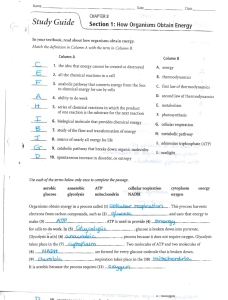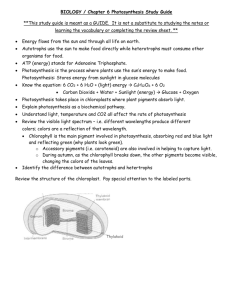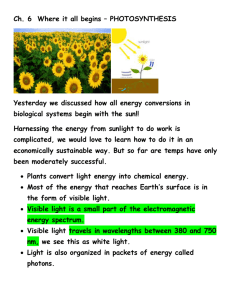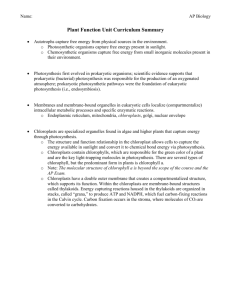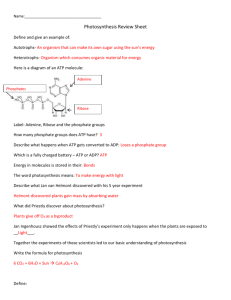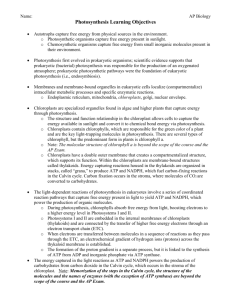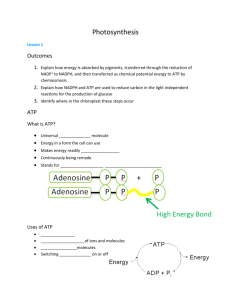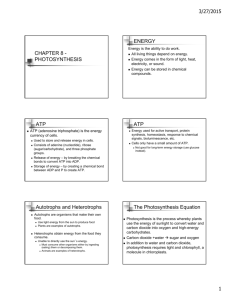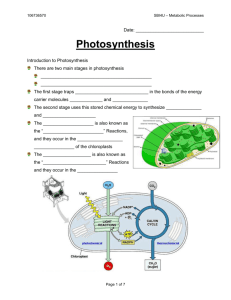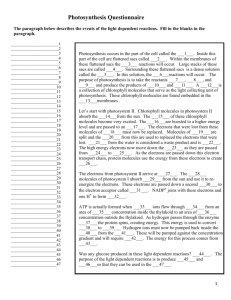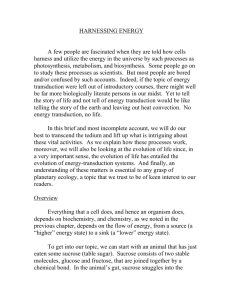Chapter 8 photosynthesis notes
advertisement
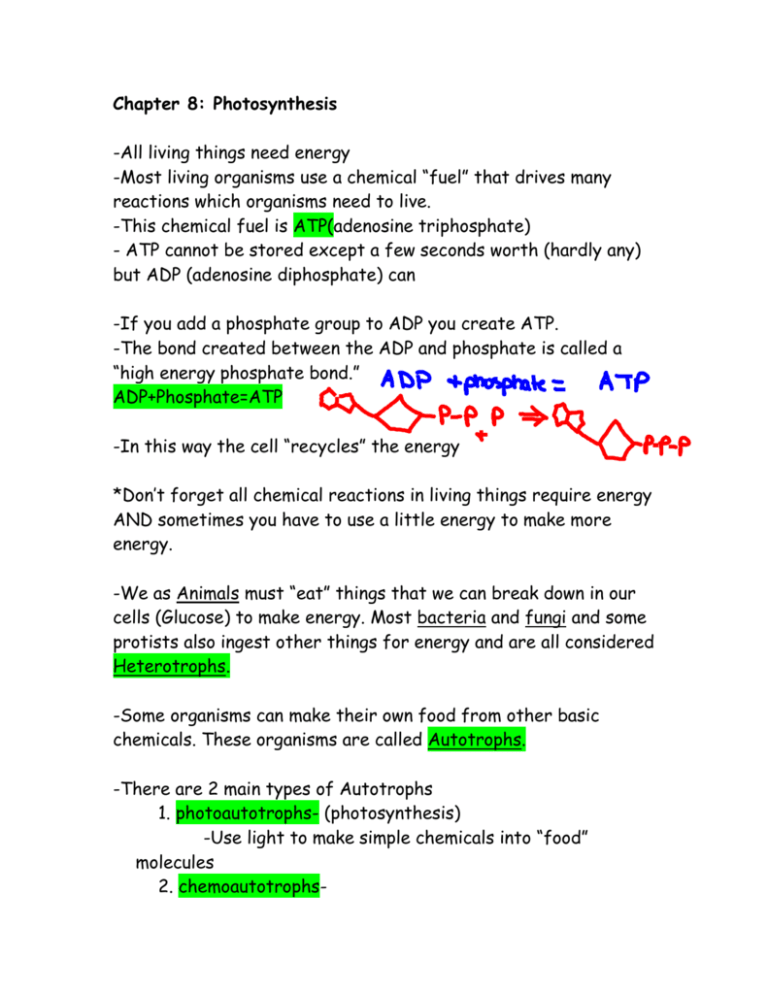
Chapter 8: Photosynthesis -All living things need energy -Most living organisms use a chemical “fuel” that drives many reactions which organisms need to live. -This chemical fuel is ATP(adenosine triphosphate) - ATP cannot be stored except a few seconds worth (hardly any) but ADP (adenosine diphosphate) can -If you add a phosphate group to ADP you create ATP. -The bond created between the ADP and phosphate is called a “high energy phosphate bond.” ADP+Phosphate=ATP -In this way the cell “recycles” the energy *Don’t forget all chemical reactions in living things require energy AND sometimes you have to use a little energy to make more energy. -We as Animals must “eat” things that we can break down in our cells (Glucose) to make energy. Most bacteria and fungi and some protists also ingest other things for energy and are all considered Heterotrophs. -Some organisms can make their own food from other basic chemicals. These organisms are called Autotrophs. -There are 2 main types of Autotrophs 1. photoautotrophs- (photosynthesis) -Use light to make simple chemicals into “food” molecules 2. chemoautotrophs- - absorb chemicals from their surroundings and converts them into “food” molecules. -Photosynthesis-process of using simple compounds and light to create larger organic food molecules -Photosynthesis occurs within an organelle called a Chloroplast. Chloroplasts are found in plant cells and some protist cells like Algae. (So plants and algae are the primary producers of “food” energy through the process of photosynthesis) - Chloroplasts collect light energy using pigments. Different pigments collect different wave lengths of light. The more pigments the more light that is collected. -The main pigments are chlorophyll a and b and carotenes. -Chlorophylls do not absorb the green wavelengths of light and therefore appear green. -Carotenes absorb no yellow, orange or red (fall colors) -The pigments are embedded within protein membrane stacks inside the chloroplast called thylakoids. -Thylakoids increase the surface area to hold more pigments and collect more light. -There is a liquid filling in the chloroplast called the Stroma-in which many chemical reactions take place. Picture page 231 -Remember Photosynthesis is about a series of chemical reactions in which glucose “food” molecules are built. -There are 2 parts of Photosynthesis 1. The light dependent reaction- -which creates high energy molecules used to build the compounds in part 2 2. The light independent reaction (dark rxn) -which builds the actual glucose molecule The Light Reaction - the light reaction occurs w/in the stacks of the thylakoid membrane - It all starts with the absorbtion of light by photosystems. - Photosystems are clusters of chlorophylls and proteins embedded in the membrane. - The process begins w/in photosystem 2 -Special chlorophyll a molecules become very excited by the sun and give up 2 high energy electrons. -These 2 electrons are passed from one molecule to the next (none want to accept them) these molecules are called the electron transport chain (ETC) -Energy from this passing of electrons (ETC) is used to pump H+ into the thylakoid space to create a gradient. -Now photosystem 1’s special chlorophyll a molecule reenergizes the electrons and they continue to pass through a second electron transport chain. -At the end of the (ETC) the 2 electrons are finally accepted by an electron accepter in the stroma called NADP +. -NADP+ will accept these electrons – and bond with a H+ to become a high energy molecule called NADPH. -Also at this time a special protein in the membrane called ATP synthase allows H+ to pass through them – this spins the protein giving it energy. This energy allows it to bond ADP and phosphate to create ATP molecules. -Now we have created NADPH and ATP which can power other cellular reactions. *What about that chlorophyll? Can it continue to give more and more electrons? No- it must be paid back. But how? Water! – We all know plants need water and sunlight - Here’s why Water H2O is split into 2 H+ ions 2 electrons and 1 oxygen atom - the H+ ions are used to create a gradient and help in ATP synthesis and NADPH production - The electrons repay the chlorophyll a molecule allowing the continued creation of NADPH Now that we have energy we are ready to build food! The Light Independent Reaction: The Calvin Cycle -During the light independent reaction ATP and NADPH from the light dependent reaction are used to produce high energy sugars. (Glucose) -Building the Glucose sugar occurs out in the stroma of the chloroplast in a series of chemical reactions called the Calvin Cycle. -CO2 enters the Calvin Cycle from the atmosphere and combines with compounds present in the stroma and produces 2 sets of 3carbon chains. -Some of the ATP and NADPH are used to make this reaction occur. -Some of these 3carbon chains will be used for the cell growth and make lipids, proteins and complex carbohydrates. -The other molecules continue to build using more ATP until they become 6carbon chains of glucose. -Glucose is an energy source that is able to be stored. -In this way solar energy can be stored as chemical energy. WOW! I wish humans could figure out how to do something like that . Bye Bye fossil fuels!!!!!!!!!!!!! Now lets think about the plants themselves. -Plants need water, light and some thermal energy-which affects the rate of photosynthesis. -you can have too much of these factors or too little. -C02 enters the plant through pores on the underside of the leaves called Stomata, which can open and close. -plants in extreme weather may keep their stomata closed to try to conserve water. -There are 2 adaptations. Alternate pathways which these plants may take….. C4 photosynthesis- able to use low levels of co2 and uses a 4 carbon chain Ex: corn, sugarcane CAM plants- only open stomata at night – usually desert plants
